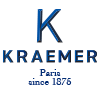Patronage of Galerie Kraemer
Art is a passion to be shared
For many years, Galerie Kraemer has been committed to being a benefactor of institutions, museums, and foundations.
These commitments are realized through the donation of objects, which are now on public display, the acquisition of certain works, or renovation projects.
Galerie Kraemer is a patron of the Château de Versailles, the Louvre museum, the Nissim de Camondo museum, the Museum of Decorative Arts (MAD), the Jacquemart-André museum, the mahJ, to name just a few.
